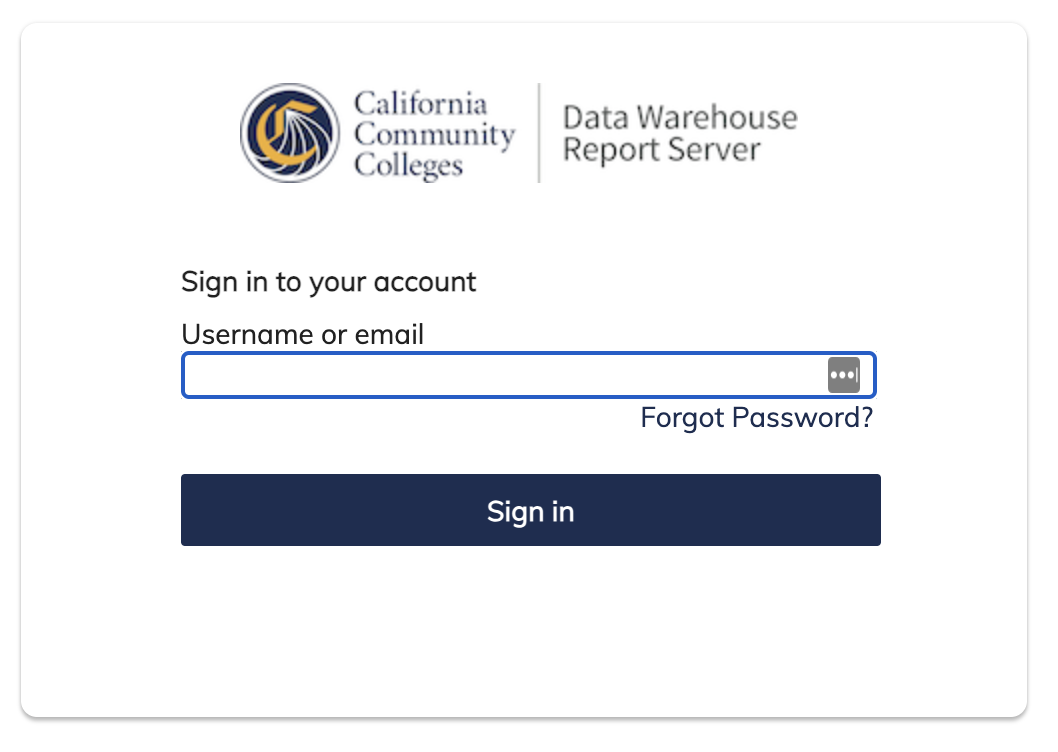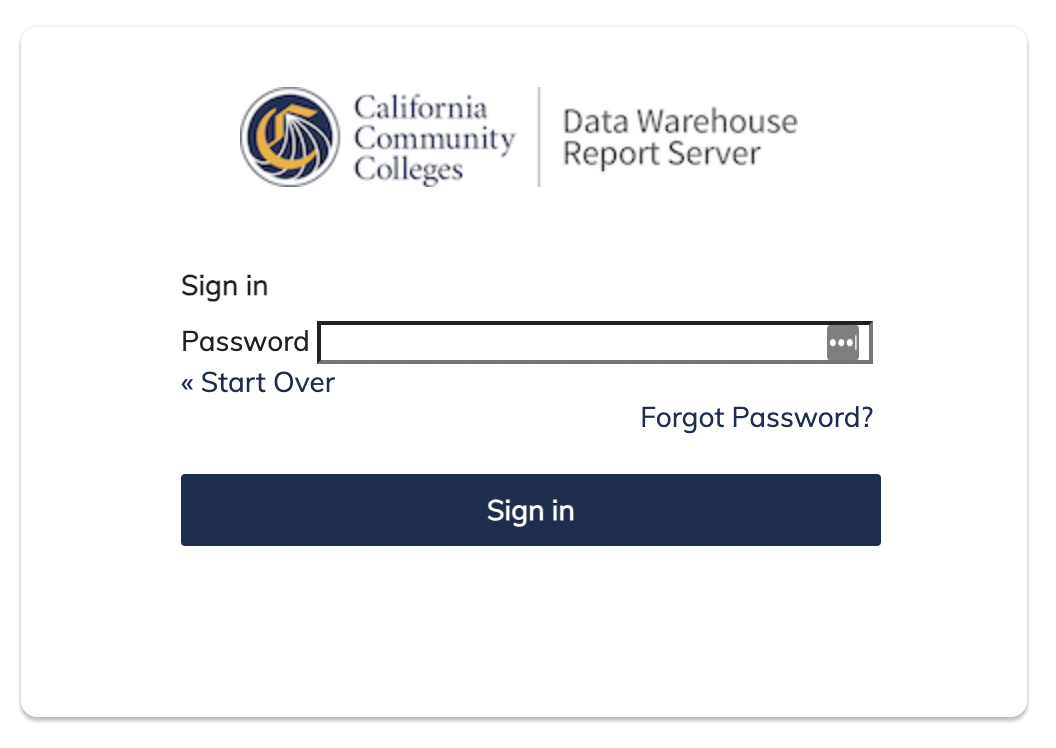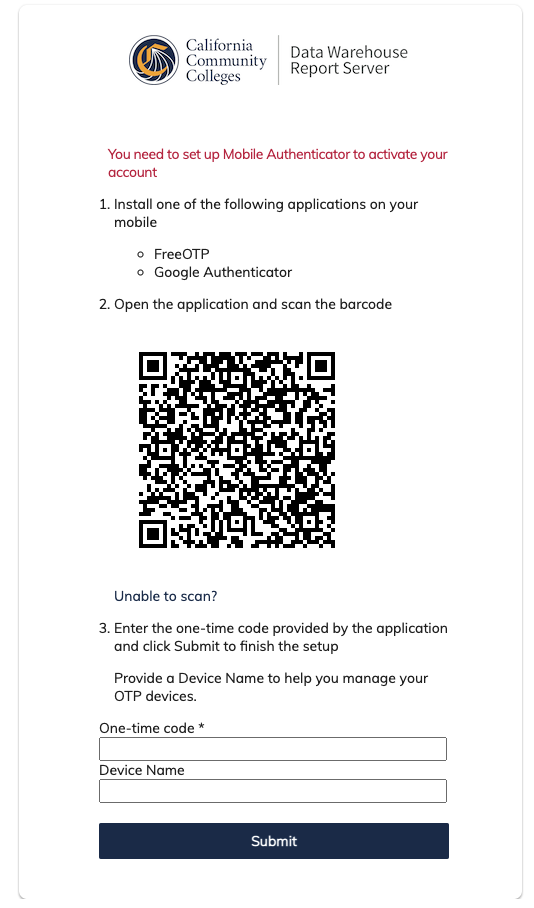| Panel | ||||||
|---|---|---|---|---|---|---|
| ||||||
This guide is for the Data Warehouse Report Server (CCC Data 2.25.0) released to production on January 27August 16, 2023. |
In This User Guide
...
Access to the DW Report Server is restricted to authorized users to ensure the privacy and security of the data within the CCC Data Warehouse. Users must request access using via one of the appropriate processes below , and upon approval will be granted an account based on their user type.
...
| Panel | ||||||
|---|---|---|---|---|---|---|
| ||||||
Contact your College Relationship Manager (CRM) from the CCCTC Enabling Services team to request authorized access or setup an approved account, today. |
User Accounts
Access to the DWRS requires an authorized user account configured based on user type. There are two types of authorized user accounts:
SSO Users: Colleges and Districts using their institution’s IDP for single sign-on. The institution’s log in may include (CCCTC does not manage your institution’s two-factor authentication (2FA) , but this SSO mechanism is not managed by the CCCTC.mechanism, if implemented.)
Non-SSO Users: CCCCO, CVCOEI, and other authorized external users will authenticate directly to the DWRS using 2FA to secure and protect our systemwide student data.
...
The process for account setup and log in will be different depending on user type, access level, and the mechanism used to authenticate. Working with an Implementation & Configuration Engineer (ICE) from the CCCTC Enabling Services team to set up and configure your account, college & district users (SSO Users) will be are provided a custom URL configured to your institution’s institution MIS code and internal IdP link. Non-SSO Users will be directed to the DWRS directly URL to log in and complete additional setup & verification tasks steps to facilitate authentication.
Below is an explanation of the setup process followed by summaries of the log in process for each of the two authentication methods.
Pre-requisites
Prerequisites for All Users
Before a user can log into in to the DWRS the following conditions must be met:
You - the The authorized user - have has followed the Getting Started tips above and have has coordinated with CCCTC Enabling Services to begin the account creation setup and configuration process based on your user type and access level.
CCCTC Enabling Services has created added and configured your account with the appropriate roles and attributes, and has sent your account credentials via secure method.Your account has been configured with the appropriate role(s), attributes, and your college or district’s IDP information (
for college and district SSO Users ONLY).SSO Users Only: You have bookmarked your unique college or district DWRS URL bookmarked and you know your institution’s IdP single sign-on credentials provided (managed locally by your college or district IT department).
Non-SSO Users Only: You have received your account credentials and temporary password from a CCCTC Enabling Services Administrator; youhave , installed an the authentication software app, and have completed the “First-Time User Log In” process required to facilitate initiate two-factor authentication.
...
SSO Users: Account Setup & Log In Process
Colleges College & DistrictsDistrict Users
The User coordinates with the CCCTC Enabling Services
...
team to ensure their account is configured with the required roles, attributes, and
...
IDP
...
link.
The User is
...
provided the appropriate DWRS URL for their IDP and logs in.
The User is authenticated locally through their
...
institution’s IDP (SSO) and
...
logs in to the DWRS.
| Panel | ||||||
|---|---|---|---|---|---|---|
| ||||||
College & district user credentials are set by their institution IdP for single sign-on (SSO). These users should know their unique credentials or should contact their institution’s IT department to change or update themusers should contact their institution’s IT team for information on their local SSO credentials. These credentials are not managed by the CCCTC. |
Non-SSO Users: Account Setup & Log In Process
All Other Users
The User coordinates with the CCCTC Enabling Services
...
team
...
to get their temporary password and first-time
...
log in information via secure method (i.e., Privnote).
The User downloads and installs compatible authentication software on their desktop or mobile device.
The User completes the “First-time User Log In” process, which enables entry of account credentials, one-time QR code verification, and authentication to the DWRS.
Optional: After logging in, the User may update their temporary password using the Forgot Password? link to reset their password.
Receiving Your Secure Account Credentials
For security purposes, all non-SSO users will receive your account credentials and a temporary password in one or two separate emails from an CCCTC Enabling Services Administrator. The email(s) will include a link to a secure Privnote message , sent to the user’s institution email address (.edu).
| Panel | ||||||
|---|---|---|---|---|---|---|
| ||||||
Note: The password will not be passed to the authorized user until they have started initiated the implementation process with the CCCTC Enabling Services teamfor added security. |
...
The First-Time User Log In Process
For Non-SSO Users Only: The first time a new non-SSO user attempts to log in to the DWRS they must establish the connection between their user account credentials, a shared secret key (QR Code), and the authentication software to enable the two-factor (2FA) log in authentication.
Pre-requisitesPrerequisites:
The User has the Data Warehouse Report Server DWRS direct access URL: (https://dw-reports.ccctechcenterccctechcenter.org/jasperserver-pro/login.html).
The User has received their account credentials from the CCCTC Implementation & Configuration a CCCTC Enabling Services Administrator.
The User has installed and configured a compatible authentication software app on their desktop and/or mobile device.
| Expand | |||||||||||||||||||||||||||||||||||||
|---|---|---|---|---|---|---|---|---|---|---|---|---|---|---|---|---|---|---|---|---|---|---|---|---|---|---|---|---|---|---|---|---|---|---|---|---|---|
| |||||||||||||||||||||||||||||||||||||
Step 1: Enter Your Account Credentials on the Log In Pages
Step 2: Scan the QR Code Page
|
...
For Non-SSO Users Only: After the user completes the one-time “First-Time User Log In” process, the user is “verified” and will not have to repeat the Scan the QR Code Page stepagain UNLESS they need to re-install their authentication software and/or generate a new QR code. For all subsequent s, the verified user needs only to enter their account credentials and the verification code retrieved from their authenticator app.
...
Step 1: Log in Page Enter Username or Email
Navigate to the Data Warehouse Report Server URL (https://dw-reports.ccctechcenter.org/jasperserver-pro/login.html) and land on the Log In page.
Enter your user account credentials and password in the input fields.
User ID: Enter your institutionalusername or institution’s email address in the
User IDinput field
(.
edu, or org) (Required)Password: Enter your unique password.
Click the “Sign In” button.
| Panel | |||||||
|---|---|---|---|---|---|---|---|
| |||||||
Tip: Your Username is your institution or organization email address used during the initial account setup with the CCCTC Enabling Services team. |
Step 2: Enter Password
Enter your password in the Password input field or click the Forgot Password? link to reset your password.
Click the “Sign In” button.
| Panel | ||||||||
|---|---|---|---|---|---|---|---|---|
| ||||||||
Reminder: Click the Forgot Password? link on the Log In page to recover your account password or to change your password at any time. |
Step 23: Enter Verification Code Page
...
Immediately upon landing on the “One-time code” screen, copy the verification code from your Authenticator app within 30 seconds of making the request (clicking on Sign In button on Log In screenafter entering password).
Verification Code: Enter the code from the authenticator app into verification code in to the “One-time code” field.
Click the “Sign in” button to complete the log in process and access the DWRS.
| Panel | ||||||
|---|---|---|---|---|---|---|
| ||||||
Best Practice: To save time retrieving your verification code, consider labelling the DWRS entry in your Authenticator tool, especially if you are using the tool for more than one application. |
Password Reset Process
To change or update your user account password:
Navigate to the Data Warehouse Report Server sign-in page at https://dw-reports.ccctechcenter.org/jasperserver-pro/login.html.
Click on the “Forgot “Forgot Password?” link that sits below the “Sign in to your account” input fields.
...
...
which is available on every screen.
...
Enter your email address that was used to create your account
...
.
Click Submit.
...
A confirmation message appears on the screen directing you to retrieve an email.
...
On the Home page, click Create in the Reports block. The Create Report wizard opens.
Select the Ad Hoc view you want to use as the basis for your report.
Select a report template. To use a template other than the default, select Custom Report Template, click Browse and select the desired template. See Report Templates for more information.
Click OK. If asked, enter the input controls needed. See Using Input Controls.
...
| Panel | ||||||
|---|---|---|---|---|---|---|
| ||||||
Creating Filters with Relative Dates You can filter information in your view based on a date range relative to the current system date. You can accomplish this using date-based filters, and entering a text expression describing the relative date or date span you want to display, using the format <Keyword>+/-<Number> where:
For example, if you want to see all of the CC Promise Grant Applications submitted during the prior week, your expression would be: WEEK-1. |
...




